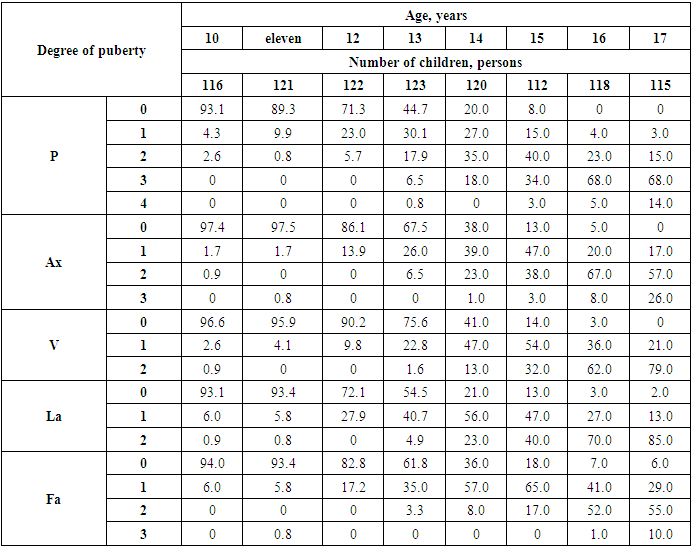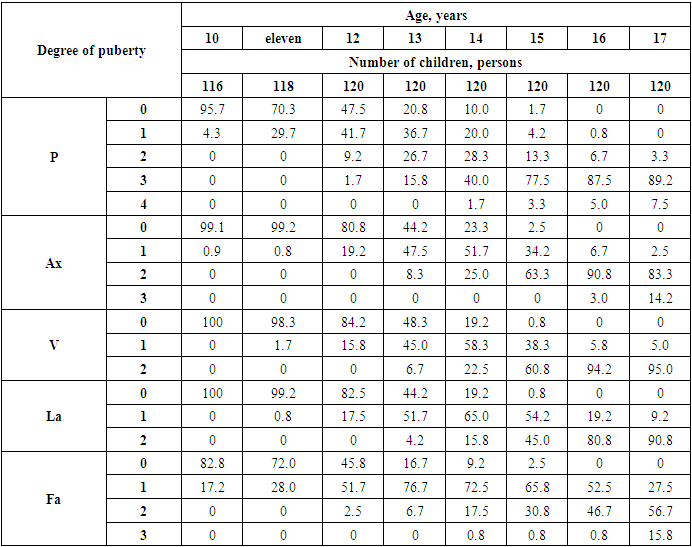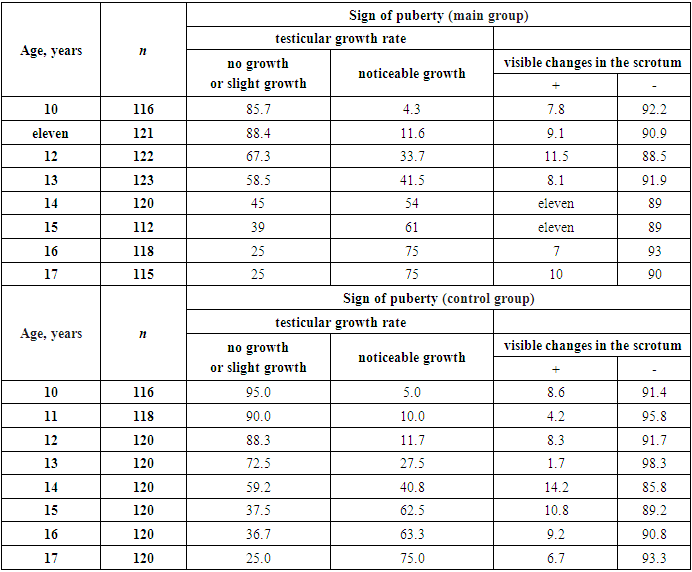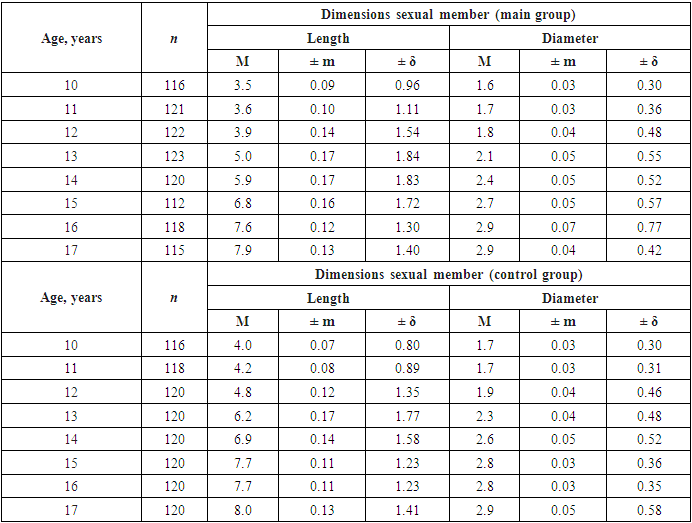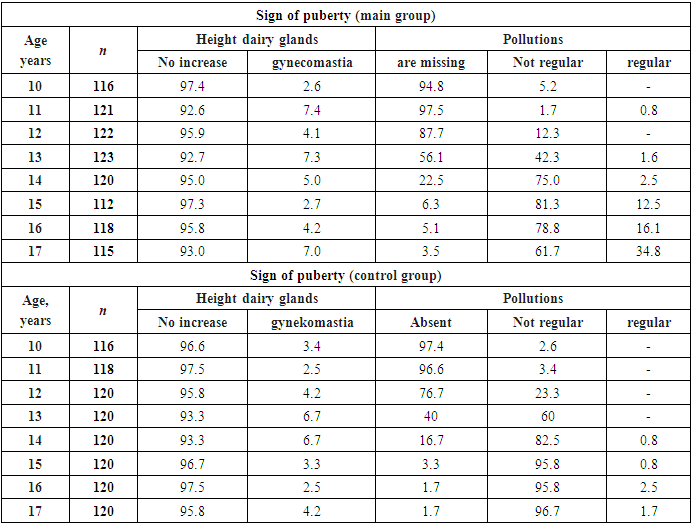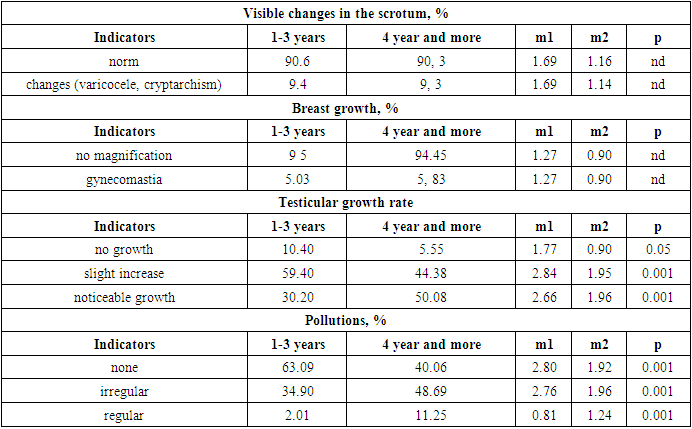-
Paper Information
- Previous Paper
- Paper Submission
-
Journal Information
- About This Journal
- Editorial Board
- Current Issue
- Archive
- Author Guidelines
- Contact Us
American Journal of Medicine and Medical Sciences
p-ISSN: 2165-901X e-ISSN: 2165-9036
2024; 14(6): 1499-1505
doi:10.5923/j.ajmms.20241406.05
Received: May 21, 2024; Accepted: Jun. 4, 2024; Published: Jun. 7, 2024

Hygienic Assessment of the Development of Secondary Sexual Characteristics of Boys, Aged 10-17
Tillaeva Sh. O.
Research Institute of Sanitation, Hygiene and Occupational Diseases, Ministry of Health of the Republic of Uzbekistan Tashkent, Republic of Uzbekistan
Correspondence to: Tillaeva Sh. O., Research Institute of Sanitation, Hygiene and Occupational Diseases, Ministry of Health of the Republic of Uzbekistan Tashkent, Republic of Uzbekistan.
Copyright © 2024 The Author(s). Published by Scientific & Academic Publishing.
This work is licensed under the Creative Commons Attribution International License (CC BY).
http://creativecommons.org/licenses/by/4.0/

In this article, boys aged 10 to 17 years old who were involved in martial arts (main group) and not involved in sports (control group) were examined in the Tashkent Youth Sports School; a total of 1901 children were examined. The level of puberty and development of secondary sexual characteristics of these boys was assessed. When comparing boys of the main and control groups, it was found that the development index of the first secondary signs corresponded to 9 years 9 months in the main group and 9 years 11 months in the control group.
Keywords: Sport, Teenage boys, Sexual development, Secondary sexual characteristics
Cite this paper: Tillaeva Sh. O., Hygienic Assessment of the Development of Secondary Sexual Characteristics of Boys, Aged 10-17, American Journal of Medicine and Medical Sciences, Vol. 14 No. 6, 2024, pp. 1499-1505. doi: 10.5923/j.ajmms.20241406.05.
1. Introduction
- Sexual development is the process of maturation of the hypothalamic-pituitary-gonadal system (HPGS), characterized by the appearance of secondary sexual characteristics and the production of mature germ cells, as well as the formation of physical, functional and psychological processes in the child’s body. Currently, puberty for children of the European population in 95% of cases occurs in the age range from 8 to 13 years in girls and from 9 to 14 years in boys.Puberty is considered very important in the physiological, psychological, moral and social development of a person, and it is during this period that the formation of all morphological and functional structures of the body is completed. One of the tasks of preventive medicine is to identify early deviations in the growth and development of children with different levels of motor activity (Hassan et al., 2023; Kamilova R.T., Tillaeva S.O., 2021). Pubertal development is considered an important time interval in a person's life and secondary sexual characteristics are assessed (Hassan, 2019; Baytrak O.A., Meshcheryakov V.V., Girsh Y.V., 2021). The physical and sexual development of children is subject to fluctuations depending on social, environmental, geographical, climatic and many other factors, as well as on the level of urbanization [Hassan, 2020; Berezin I.I., Gavryushin M.Yu., 2014; Ramadan et al., 2020].Physical activity is a powerful activator for the endocrine and cardiovascular systems of a growing organism, stimulating growth and puberty, and promoting metabolic processes (Hassan et al., 2019; Kalyuzhny E.A. 2015; Arafaa et al., 2018). Under normal conditions, physical development and puberty always proceed in parallel and are interconnected. Puberty begins with the appearance of so-called secondary sexual characteristics: pigmentation of the external genitalia, pubic and axillary hair growth, etc. At the same time, girls enter puberty approximately 2 years earlier than boys and subsequently mature faster too (https http://studfile.net/preview/2997267/page:4/).Considering the above, we set ourselves the goal of studying the sexual development of teenage boys.
2. Material and Methods
- The study included children and adolescents belonging to the Uzbek and Russian mentality, aged from 10 to 17 years. The research was conducted by athletes (main group) engaged in individual wrestling in 11 children and youth sports schools (youth sports schools) located in 10 districts of Tashkent (Bektemir, Yashnabad, Yakkasaray, Yunusabad, Mirzo Ulugbek, Almazar, Shaykhontakhur, Mirabad and Chilanzar) and carried out among children (control group) studying in 5 secondary schools (GS) (122, 218, 294, 205, 195), located in 4 districts (Chilanzar, Mirabad, Yunusabad, Mirzo-Ulugbek). A total of 1965 boys were enrolled (of which 982 were the main group, 983 were the control group).Study of secondary sexual characteristics of the Tanner scale using somatometry and somatoscopy. To measure the sexual development of adolescent children, we assessed the Tanner scale. Determined by sex formula indicators: for boys P, Ax, V, La, Fa. This indicator means P - development of pubic hair; Ah - development of hair in the armpit; V - degree of voice mutation; La - development of the Adam's apple; Fa - development of facial hair. Additional questions included the rate of growth of the testicles (scrotum), the growth of the mammary gland and visible changes in the scrotum were assessed using palpation methods, the dimensions of the penis (diameter and length) were measured using a zero cm ruler and calipers. We noted wet dreams using survey methods. For research a unified questionnaire on sexual development was developed, based on the Tanner scale indicators.The developed questionnaires were approved by the Scientific Council of the Research Institute of Sanitation, Hygiene and Occupational Diseases of the Ministry of Health of the Republic of Uzbekistan by protocol No. 2 of February 23, 2021. Children and adolescents from the study and control groups of each respondent were ensured confidentiality and were selected on the basis of voluntary consent.The obtained data were subjected to statistical analysis using Microsoft Excel 2016. The survey data were processed using the variation-statistical method with the calculation of arithmetic means (M), standard deviations (±d), and average errors (± m). Differences in arithmetic means were considered significant at (p≤0.05).
3. Results
- Survey data show that in the main group, isolated cases of the appearance of secondary sexual characteristics in boys, observed from 9 years 9 months of age, expressed in the appearance of hair on the pubis (P 1 -6.9%) and in the armpits (Ax 1 -2.6%), a change in voice timbre is noted (V 1 -3.5%), an increase in thyroid cartilage (La 1 -6.9%), as well as the appearance of single facial hair (Fa 1 -6.0%), is shown in Table 1. At 16–17 years old, many boys have mature secondary sexual genitalia signs. Thus, at the age of 16-17 years, pubic hair growth P3 degree 68% and P4 degree was noted in 20% of boys, Ax hair growth 2 and 3 degrees in the axillary region - in 79%. At the same age, the initial stages of development of hair on the pubis were P1-3.5%, and in the axillary region Ax1 - 18.5% of boys.
|
|
|
|
|
|
4. Discussions
- St. Petersburg olimlari tomonidan olib borilgan tadqiqot ishiga kura, Armpit hair growth begins later; at the age of 12 years, 33% of the examined schoolchildren had axillarche of the 1st and 2nd degrees (V.L. Gritsinskaya, S.M. Mamedova, I.L. Nikitina, 2018). According to the results of our research, hair growth in the armpits begins in athletes at the age of 10 - 1.7%, in schoolchildren at the same age - 0.9%.At 14 years of age, 18.7% of boys had 0 degree of severity of secondary sexual characteristics; at 15 years of age, boys with 0 degree of severity of secondary sexual characteristics were absent, while 68.7% had degree III of severity of hair in the armpits, and 58 on the pubis..8% of surveyed young men (Kuchma, V.R., Skoblina, N.A., Bokareva, N.A., Milushkina O.Yu., 2012). The result of our study showed that 14-year-old boys of the main group had 31.2% 0 level of development of secondary sexual characteristics, 16.2% of children in the control group and 13.2% of 15-year-old boys in the main group had a development level of 0 degree, in children of the control group - 2%. At the same age in both groups, 4.0 % had degree III hair in the armpits, and 42.4% of the examined adolescent boys had hair on the pubis.A study conducted among Chelyabinsk adolescents showed that, from time to time, the maximum expression of secondary sexual characteristics (SCH) is characteristic of boys aged from 13 to 16 years (Uzunova A.N., Lopatina D.A. et al., 2014). According to the results of our study, the highest level of development of secondary sexual characteristics in boys was at the age of 12-15 years.
5. Conclusions
- Thus, we can conclude that it has been established that the appearance of secondary sexual characteristics in boys, observed from 9 years 9 months of age.Thus, in the change in voice timbre V 1-2 -3.5% - 10 year old boys in the main groups, V 1 -1.7% in the control groups, increase in thyroid cartilage in 11 year old children of the main group La 1-2 in 8, 3 times higher than in children of the control group, and also, the appearance of single facial hair Fa 1 among 10 year old boys of both groups was found to be 2.9 times higher in the control group.Testicular development in 10-year-old children in the control group was 1.6% less than in the main group. 9 age groups in the main groups of boys, the length of the penis increased by 4.4±0.14 cm, and in the control group - by 4±0.12 cm.It was found that in the children of the main group the level of regular emissions was 20.5 times higher than in the children of the control group. It was found that martial arts and high training loads have an effect on slowing down the rate of testicular growth (P < 0.05-0.001) and may have an effect on wet dreams (P <0.05-0.001).In order to correctly distribute the load during sports training, it is recommended to strictly observe the age and physical condition of each child, as well as the duration of training.
 Abstract
Abstract Reference
Reference Full-Text PDF
Full-Text PDF Full-text HTML
Full-text HTML